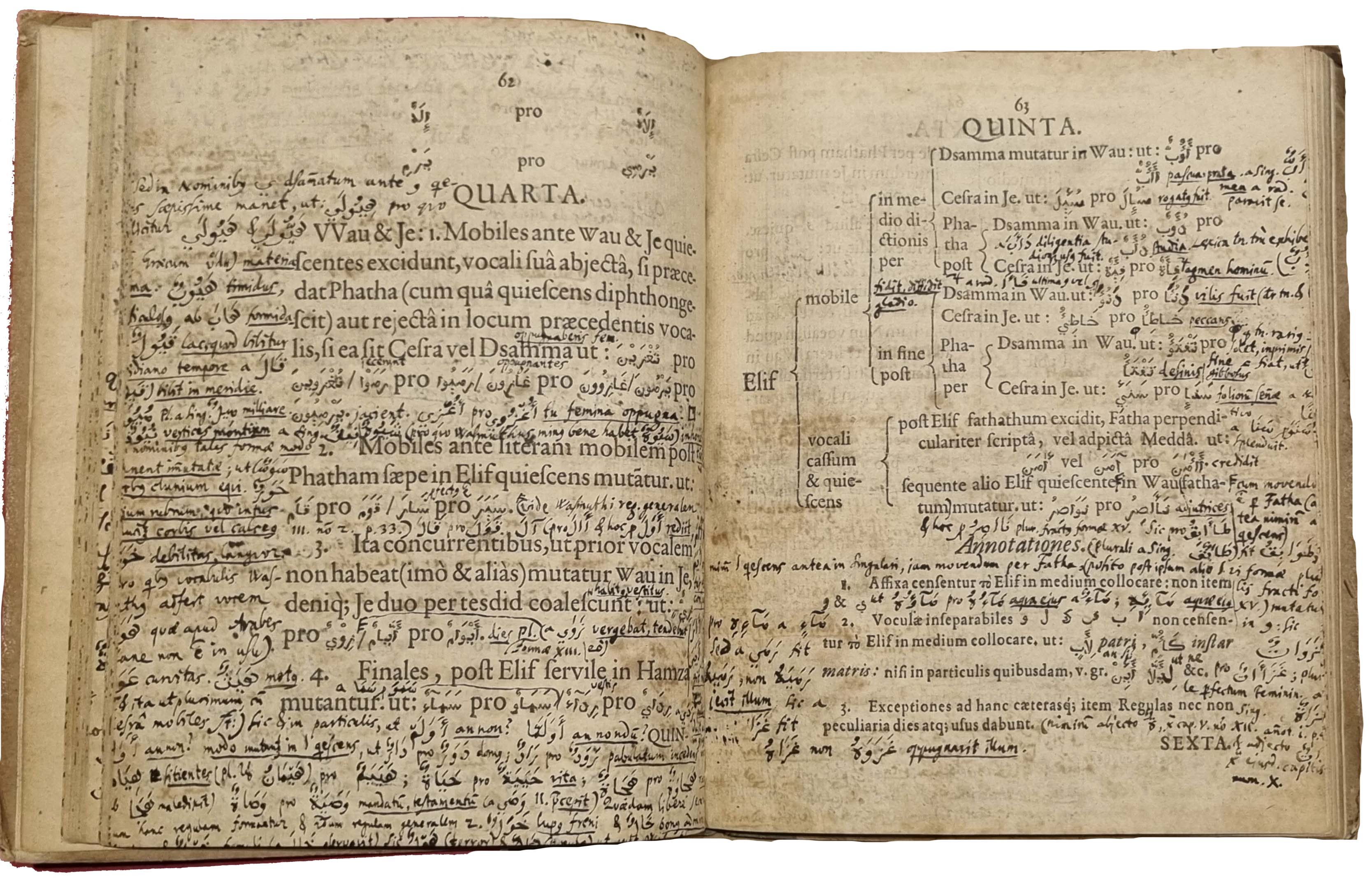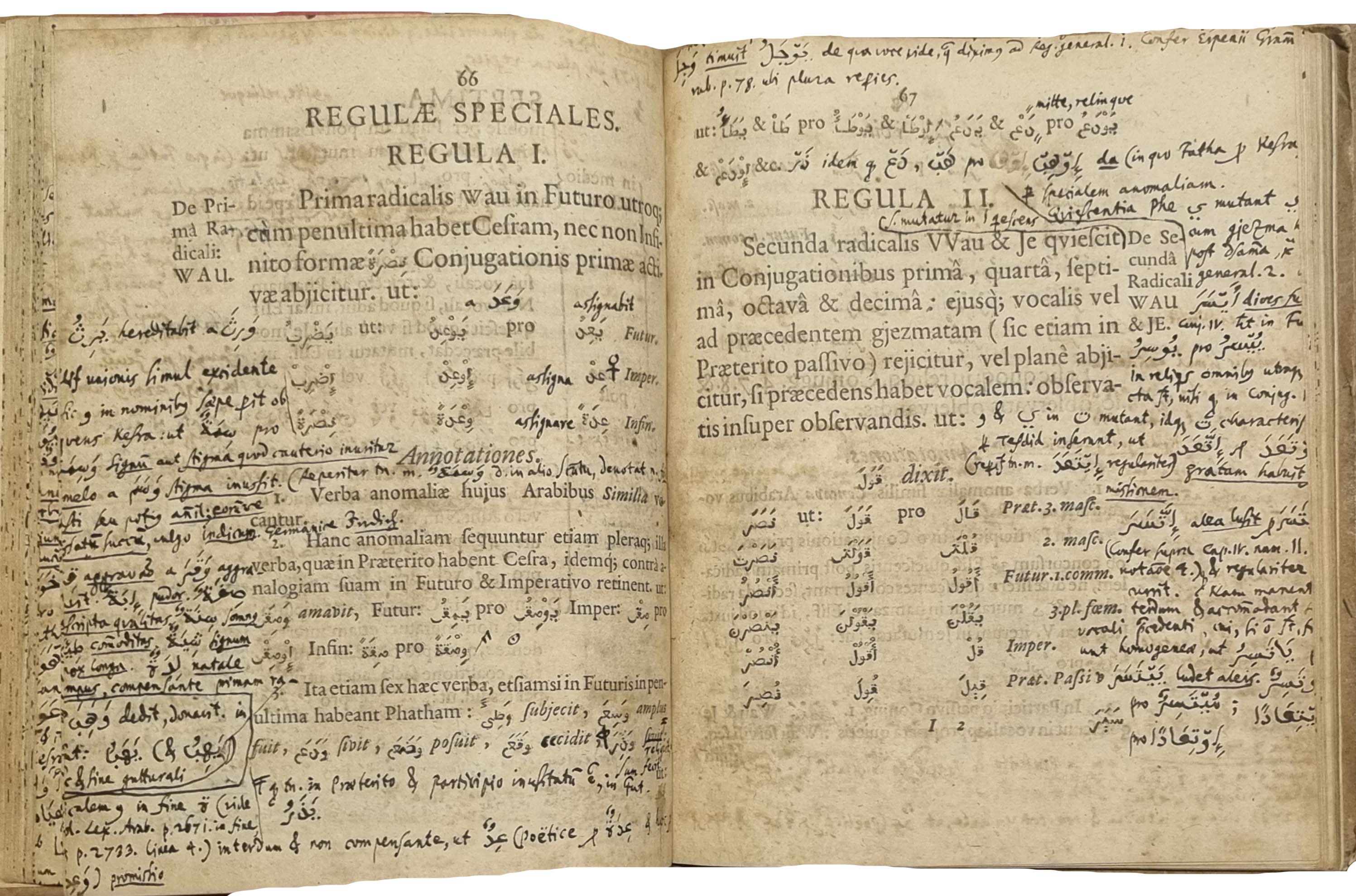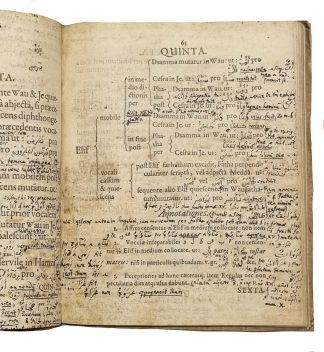SENNERT, Andreas.
EXTENSIVELY ANNOTATED BY AN EARLY ARABIST
Arabismus, h.e. Praecepta Arabicae Linguae.
Wittenberg, Job Wilhelm Fincelius, 1658£5,750.00
FIRST EDITION. 4to. pp. [8], 166. Arabic letter, with Roman, little Italic. Decorated initials and ornaments. General light browning. c1900 ink stamp of the Jesuit College of Jersey to title recto (faint) and verso, c1800 round ink stamp TH to title. 51 pages with ms annotations in Arabic and Latin in a cursive Germanic hand c.1670-80, a dozen extensively so, slightly trimmed to upper and outer margin but perfectly legible, two C20 paper slips with inked ms notes, one tipped-in, the other pasted to rear pastedown. A good copy in C19 paper boards, gilt label, loss to spine, hinges starting but firm.
A most interesting copy of the first edition of this famous Arabic grammar printed in Wittenberg – with extensive annotations from a learned scholar c.1680-90. Western annotations in Arabic at this date are most uncommon. Son of the physician Daniel Sennert, Andreas (1606-89) was a pupil of the renowned Arabist Johannes Golius, and professor of Oriental Languages and librarian at Wittenberg from 1640 until his death. ‘[He] had a significant impact in shaping the further course of studies in Hebrew and Oriental languages […]. He had a special interest in Arabic […] not only as an additional philological tool for interpreting the Old Testament but also because of its importance as a still living language and a means for direct access to the scientific writings of the Arabs’ (Miletto, p.17).
‘Arabismus’ is an Arabic grammar explained comparatively. It includes chapters on the Arabic script, verbs, nouns, adjectives, and numbers, and is followed by an Arabic-Latin dictionary, based on Germanus’ ‘Fabrica Linguae Arabicae’ (1639) and al-Firuzabadi’s C14 ‘Qamus’. The copious annotations, produced by a knowledgeable scholar c.1680-90, are a treasure trove on early Arabic studies. The closest appears to be the hand of Adriaan Reland (1676-1718), the famous Dutch orientalist, professor at Utrecht.
Among the (Protestant) sources mentioned by the annotator are Edward Pococke’s ‘Oratio’ in ‘Carmen Tograi’ (1661), Wasmuth’s (1654) and Erpenius’ grammars, Cappel’s ‘Arcanum punctuationis’ (1624), but also the Arabic Gospels (Rome, 1590/1). The first notes discuss Arabic script in relation to the Hebrew, with a focus on the original absence of dots on Arabic letters. The annotator added Wasmuth’s subdivision of the ‘awzaan’ into three classes, and integrated a great number of examples (e.g., the use of ‘fatha’ in the negated future, diptote noun rules, plurals, a reference to a word used in the Tamimi dialect, etc.) from Erpenius’ grammar, which he cross-referenced so frequently and carefully as to make it possible to identify the edition, that of 1656. The annotator even compared a section on the plurals of nouns with quadriliteral roots mentioning that Erpenius, Golius, Wasmuth, and Sennert himself used examples ‘not to the point’, unlike E. Castell in ‘Lexicon Heptaglotton’ (1669) (p.48). He profusely annotated the chapter on apophonic vowel changes of ya, waw and alif, commenting on Wasmuth’s explanation and Giggeius’ in ‘Thesaurus linguae arabicae’ (1632). He had access to a very specialised library, including books not present at Wittenberg (as per Sennert’s catalogue dated 1678), e.g., T. Hackspan’s ‘Fides et leges Mohammaedis’ (1646) (of which he mentions p.27 ‘if one adds the page numbers’; indeed, the book’s pages are unnumbered).
G. Miletto & G. Veltri, ‘Introduction: Hebrew Studies in Wittenberg’, EJJS 6.1 (2012), pp.1-22; B. Jaski, ‘The Manuscript Collection of Adriaan Reland in the University Library of Utrecht and Beyond’, The Orient in Utrecht (2020), 321-61.





